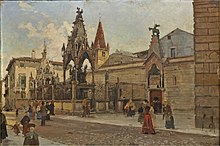Scaliger tombs

The Scaliger tombs ( ital. Arche scaligere ) in the northern Italian city of Verona are reminiscent of the burial place of the Scaliger , who acted as city lords of Verona from 1260 to 1387.
investment
Most of the family's tombs are located in a family cemetery that is fenced off with wrought iron bars next to the small church of Santa Maria Antica. Only the tomb of Cangrande I († 1329) is integrated into the facade of the church outside of this area. The other monuments mostly consist of stone-worked sarcophagi, some of which are in large tombs ( arche ) in the form of Gothic shrines ( tempietti ), which are often supplemented with equestrian statues . They are not connected to the church, but are located next to it in a fenced area. The tombs from the 14th century, often inflated with equestrian statues, are among the oldest post-antique monumental representations of their kind. The Scaliger graves were a popular motif of 19th century painters; see, for example, Eduard Gerhardt .
Santa Maria Antica
The small church is a Romanesque building consecrated in 1185. Soon after the Scaligans took control of Verona in 1260, they made Santa Maria Antica their home church. A baroque renovation around 1630 was reversed in 1897 and the vaults were renewed.
Inside, the original basic form with the three naves closed by apses is clear again; the outer walls show the layering of brick and tufa that is typical of Verona.
The tomb of Cangrande I († 1329) is located in a wall niche above the north side portal of the church . The prince is depicted as an equestrian statue at the top of the monument.
Family cemetery
The Scaliger family cemetery is located between the church of Santa Maria Antica and the former residence of the family and is surrounded by a wall with beautiful wrought iron bars from the 14th century.
The oldest of the Scaliger graves is that of Mastino I († 1277), a wall niche grave on the outer wall of the church. The grave slab of Alberto I († 1301) already shows the deceased as a rider, even if only in relief. In addition to the free-standing ceremonial graves of Mastino II († 1351) and Cansignorio († 1375) discussed below, the family cemetery also contains the simple tombs of Bartolomeo I († 1304), Cangrande II († 1359) and Bartolomeo II. († 1381).
Important tombs
Tomb of Cangrande I († 1329)

A canopy protrudes over the north portal of the church, under which Cangrande I , the most important Scaliger, is buried. Two dogs (dog, it .: cano ), which hold the ladder coat of arms (ladder, it .: scala ) of the Scaliger, carry the sarcophagus richly decorated with reliefs. The reclining figure of the dead man rests above it. The Gothic canopy was originally open to the church, so the tomb was visible from inside and outside. A copy of the original equestrian statue is set up high on the canopy roof; the previously fallen original has been in the city's Castelvecchio Museum since 1907 . Although the horse is standing calmly, the turning of the heads towards the viewer in the churchyard, the slightly waving saddlecloth and the smile reveal a physical and emotional agitation. The reclining figure smiles too. But the expression “is not to be understood as an individual trait. It is a traditional attribute of the virtuous ruler ”, at best a“ conventional mask ”(Seiler). It had only spread to sculpture in Central Europe with the Gothic period.
Tomb of Mastino II († 1351)

Even during his lifetime, Mastino II , the nephew and successor of Cangrande I, had the free-standing canopy tomb erected on the fenced area of the family cemetery around 1345-1350 . The tomb has the shape of a tabernacle. Four pillars support a platform on which the sarcophagus and canopy stand. The deceased is depicted both as a reclining figure on the tumbler box and high up on the steep pyramidal roof as a below-life equestrian figure in full armor and with a closed visor. The side gables of the canopy show scenes from the Old Testament .
Tomb of Cansignorio († 1375)

The Scaliger grave monument, though not of the highest quality, is richly decorated by the sculptor Bonino da Campione 1375–1376 for Cansignorio (it .: cansignorio = lead dog), a son of Mastino II. On a hexagonal floor plan, one of six holy knights surrounds under canopies Guarded barrier the monument with the now traditional structure: round supports - platform plate - tumba - reclining figure - canopy - roof structure - equestrian figure, just decorative, architecturally and sculpturally enriched.
Individual evidence
- ↑ Peter Seiler: The smile of the Cangrande della Scala . In: Zeitschrift für Kunstgeschichte 62 (1999), pp. 136–143, with additional literature. Also digital: [1]
literature
- Manfred Wundram (Ed.): Upper Italy East (Reclam's Art Guide Italy Vol. 2) , pp. 1034-1037.
- Peter Seiler: Medieval equestrian monuments. Studies on personal monument setting in the Italian communes and signories of the 13th and 14th centuries , Phil. Diss., University of Heidelberg 1989, Vol. I, 260–319 and Vol. II, 97–268.
- Peter Seiler: residence, church, burial place. On the genesis of the Scaliger residence ensemble in Verona , in: Architectural Studies in Memory of Richard Krautheimer, ed. by Cecil L. Striker, Mainz 1996, 151–156.
Web links
Coordinates: 45 ° 26 ′ 37.1 ″ N , 10 ° 59 ′ 56.1 ″ E

